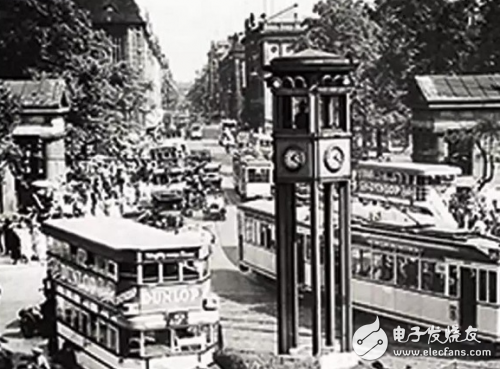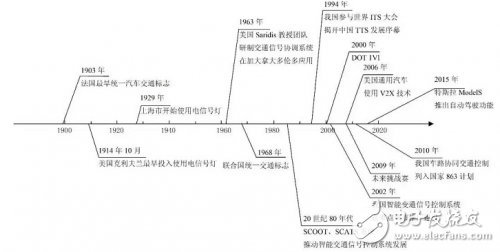All the way without lights, everywhere, will become the cross-research hotspots in many fields such as artificial intelligence, automation, control theory, intelligent transportation, and smart cars in the next 50 years. Traffic congestion, safe travel, and convenient transportation are among the major problems facing ground transportation. From the history of road traffic development, human beings have experienced or experienced six major periods: no control, traffic signal marking control, single-point traffic control, intelligent traffic control, road coordination, and driverless driving. These are all around the research and practice of how to determine the ownership of road rights fairly and efficiently, and how to effectively convey the information of road rights to traffic participants. With the development of technologies such as car networking and driverless driving, the future transportation system will gradually realize that there are no traffic signal facilities on the road, but it is still open everywhere. And this is exactly what we are looking for, the ground transportation mode that really meets the actual needs. In modern society, ground transportation is closely related to each of us. In the current complex and crowded urban roads, how to ensure the safety and convenience of traffic travel is a hot issue of public interest and scientific research workers at home and abroad. Figure | Five-way traffic lighthouse at the Potsdamer Platz in Berlin, Germany, 1924 One of the important ways to achieve this is to implement effective traffic control. Many researchers have used the electric traffic lights that appeared in Cleveland, Ohio, in 1914 as the real problem of the ground traffic control system. In the past 100 years, traffic control has undergone profound changes from theoretical methods to product systems. However, under the pressure of increasing traffic demand, existing traffic control methods have gradually reached performance ceilings. How to develop ground traffic control in the future is an important issue for all researchers. The so-called Right of Way (referred to as road rights) can be understood as the priority possession and use rights of road resources in a specific time and space. Similar to the rail locking mechanism of the railway, ground driving also needs to ensure that at most one vehicle exists in a specific time and space. In other words, if we divide the road resources into space-time grids according to the time and space dimensions, with the minimum time and the minimum space as the division units, then each grid can only be occupied by at most one vehicle. If this rule is violated, a collision will occur. Historical ground traffic control has developed around how to properly and properly solve the problem of road rights competition. After 100 years of development, the transportation system has experienced several stages such as no-control period, marking line control period, single-point timing traffic signal control period, intelligent traffic control period, vehicle road coordination period and automatic driving period. The timeline in the figure below depicts the age of typical events at home and abroad that mark the switching points of these periods. Figure | Ground-based traffic control century-old development timeline In view of this, we review several key transition points of the development of ground traffic control over the past 100 years from the new perspective of road rights, and compare the acquisition methods and performance of traffic rights in each period. In particular, we explored the distribution of traffic rights based on planned allocation or bidding, and analyzed the development direction of ground traffic control in the next 50 years, in combination with the emerging emerging vehicle networking, unmanned vehicles and autonomous driving technologies. At first, when people encountered road disputes, they often followed the basic principle of “first come, first served, and politeâ€. Based on the results of their respective visuals, the drivers on both sides decide who will pass the conflict zone first and follow their own acquiescence. In fact, this is also the basic way of determining road rights that has been followed since walking, riding and driving. However, there are many problems with this way of determining road rights: 1) The decision method is very dependent on the driver's correct perception and reasonable judgment of the surrounding environment. In the case of fast speed, poor line of sight, and complicated traffic conditions, it is difficult for the driver to accurately determine when and where a collision will occur, and thus it is impossible to determine the ownership of the right. 2) The decision method requires multiple drivers to communicate in a way that can be understood together. When the lights have not yet appeared, the driver will extend the arms out of the window and express their driving intentions through different gestures. Even today, when the lights are already a must-have for the vehicle, the driver often uses the eyes and gestures to assist in the lane change and parallel operation. To this end, Google also submitted a patent for the exchange of unmanned vehicles and human drivers in 2015. However, there is no uniform interaction standard for gesture communication. The way people gestate or look at each other varies greatly; especially due to historical and cultural differences, different countries and regions may have different interpretations of the same gesture. Secondly, the communication speed of gesture communication is slow, the visual distance is short, and the negotiation efficiency is low. When the vehicle speed is high, it is easy to cause errors and cause traffic accidents. 3) The decision method depends to a large extent on the driver's personal pledge spirit. The distribution of road rights is likely to change from “cooperation†to “competition†or even “robbingâ€. Based on these three points, the tacit understanding of road rights negotiations is difficult to achieve effectively in a short period of time. Therefore, this way of deciding the road is gradually replaced by new traffic control methods in the automobile era. As early as in the Zhou Dynasty of China, there have been records of "listing trees to express their views." There are also milestones and signposts on the military avenues of the Roman era. But these are just marking road information and do not indicate road rights. In 1903, due to the active advancement of the French Automobile Federation, France became the first country in the world to use a unified automobile traffic sign nationwide. It was not until 1930 that the unified traffic sign law was recognized throughout the UK, making traffic signs more standardized. In 1935, the first edition of the US Manual of United Traffic Control Devices was published, and the methods and standards for the production of traffic signs were unified throughout the United States. At this stage, traffic signs still have the primary responsibility of alerting the driver to danger. For example, the French traffic sign used white lacquer on the black wooden board to write "left turn", "right turn", "bridge" and other words to remind the driver. In 1968, the United Nations promulgated the "Road Traffic and Road Signs and Signals Agreement" as the basis for countries to develop traffic signs. Since then, the traffic signs of various countries have gradually developed in the direction of international unification in terms of classification, shape, color and pattern. Ground transportation has entered the era of “all walks of lifeâ€. Road traffic signs often use graphical symbols and text to convey information about specific traffic regulations and traffic control methods. Road traffic markings are the infrastructure for road traffic markings, arrows, text, elevation markings, prominent roadsides, road contours, and other traffic ground lanes and road rights. Both of these functions are intended to regulate, direct, control, and distribute traffic flow, either alone or in combination. The advantage of traffic sign marking control is that the cost is low and durable, and people's understanding of road rights is minimized. It is the most important static traffic facility in road traffic, which clearly identifies the right to use, the right of first move, and the right to occupy roads. In particular, the introduction of lane lines greatly simplifies the distribution of vehicle road rights and reduces the risk of collisions between vehicles. However, the traffic sign markings are difficult to control and guide the road rights of vehicles in different directions in the traffic conflict points (intersections and entrance ramps). Therefore, traffic signal control has become the focus of research on ground traffic control. 3.2V Cylindrical Battery,3.2V Lifepo4 Battery,3.2V 100Ah Lifepo4 Battery,Solar Lifepo4 Battery Langrui Energy (Shenzhen) Co.,Ltd , https://www.langruibattery.com

Model
Nominal Voltage
Nominal Capacity
Nominal impedance
Dimension
Charge-discharge standard
Approx Weight
(V)
(mAh)
(mQ)
Diameter
Height
Charge
Discharge
≈g
ICR10220
3.7
130
<150
10
22
0.5C-1C
0.5C-1C
4.1
ICR10440
3.7
350
<120
10
44
0.5C-1C
0.5C-1C
9
ICR14430
3.7
650
<100
13.8
42.8
0.5C-1C
0.5C-1C
17
ICR14500
3.7
900
<80
14
50
0.5C-1C
0.5C-1C
19.5
ICR17280
3.7
600
<100
16.3
28
0.5C-1C
0.5C-1C
15
ICR17335
3.7
700
<100
16.3
33.5
0.5C-1C
0.5C-1C
18
ICR18500
3.7
1400
<70
18.1
50
0.5C-1C
0.5C-1C
33
ICR18650
3.7
2000
<50
18.1
64.8
0.5C-1C
0.5C-1C
45
ICR18650P
3.7
2000
<40
18.1
65
0.5C-1C
3C-5C
45
ICR18650P
3.7
2200
<40
18.1
65
0.5C-1C
3C-5C
45
ICR18650
3.7
2600
<70
18.1
64.8
0.5C-1C
0.5C-1C
45
ICR26650
3.7
3500
<30
26
65.5
0.5C-1C
0.5C-1C
85
ICR26650P
3.7
5000
<30
26
65.5
0.5C-1C
0.5C-1C
85
ICR18650P
3.7
1500
<15
18.1
64.8
1C
10C-15C
47
ICR26650P
3.7
2200
<15
26
64.8
1C
10C-15C
64
IFR14430E
3.2
400
<115
13.8
43
0.5C-1C
0.5C-1C
15
IFR14500E
3.2
400
<95
13.8
50.2
0.5C-1C
0.5C-1C
15.5
IFR14500E
3.2
650
<80
13.8
50.2
0.5C-1C
0.5C-1C
17.8
IFR18500E
3.2
600
<80
18
50
0.5C-1C
0.5C-1C
19.5
IFR18500E
3.2
1200
<80
18
64.8
0.5C-1C
0.5C-1C
30.4
IFR18650E
3.2
1500
<65
18
64.8
0.5C-1C
0.5C-1C
40.5
IFR18650E
3.2
1700
<80
18
65.3
0.5C-1C
0.5C-1C
41.2
IFR26650E
3.2
3400
<20
26
65.3
0.5C-1C
0.5C-1C
87
IFR18650P
3.2
1100
<20
18
65.3
1-3C
10-25C
40
IFR26650P
3.2
2400
<20
26
65.3
1-3C
10-25C
82